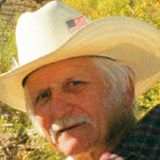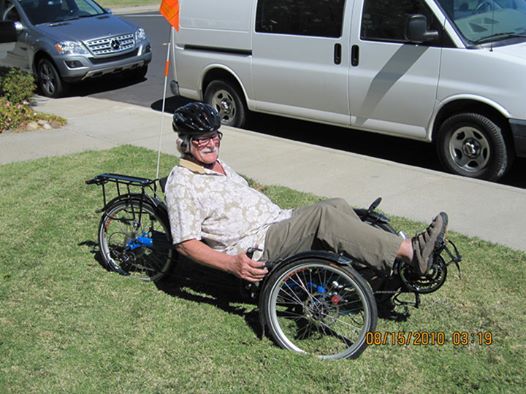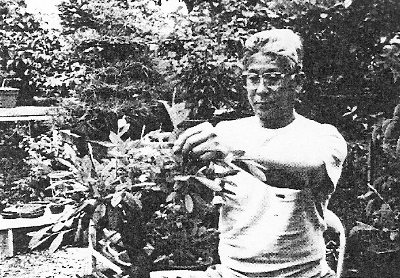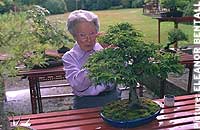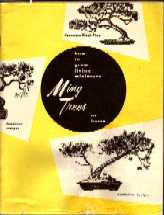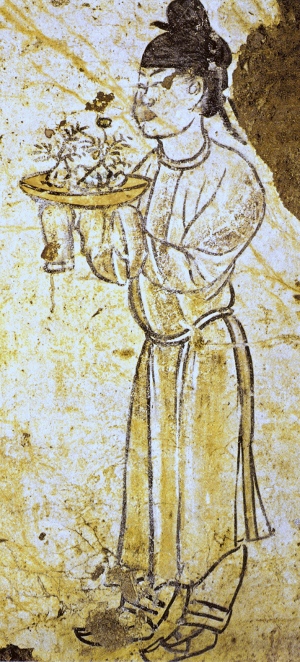| 21 |
1973 -- Dorothy Young, President of the American Bonsai Society, and Beverly Oliver, President of Bonsai Clubs
International, signed a resolution extending wholehearted support for the establishment of a National Bonsai
Collection at the National Arboretum in Washington, D.C. This was during the joint Bonsai Congress in
Atlanta, Georgia. There Dr. John Creech, the Third Director of the Arboretum, put forth the concept of a
National Bonsai Center to house trees to be gifted to this country by the Japanese as part of the U.S.
Bicentennial three years hence. The concept had initially been discussed at the 1973 spring show of the
Potomac Bonsai Association. Its acceptance now by these two principal bonsai organizations -- and master
Yuji Yoshimura, who was in attendance and who had expressed
earlier his dream that the richest nation in the world should have a National Bonsai Collection -- helped
persuade the Japanese people that America was earnest about participation in this gardening art.
"Beverly Oliver, President of Bonsai Clubs International, reading a proclamation honoring the Hindses."
(The Bonsai Saga by Dr. John Creech, pg. 17) SEE ALSO: Feb 19, Mar 1, Jul 9
(International Bonsai Digest Presents Bonsai Gems, Fall 1974, pg. 89) |
||||
| 22 |
2021 -- Paiman Mak suddenly passed away. (Born on August 28, 1944 in
Indonesia, he was a founder and Chairman of Asia Pacific Bonsai and Suiseki Convention (ASPAC), launching the
first ASPAC in Bali in 1991 with Ismail Saleh. Participants from 19 countries attended this convention and
it was a great success. Since then, ASPAC has been held once every two years. Mr. Paiman was Chairman
of the 9th ASPAC in 2007, and presented demos in at least 4 others (3rd, 1995; 5th, 1999; 7th, 2003; and 8th,
2005). His contributions and lectures to the bonsai and suiseki circle were immeasurable and commendable.
Pameran/Kontes Nasional Bonsai & Suiseki 2013, the official record of the national exhibition of bonsai
and stones that was held in Indonesia that year, included both a two-page introduction to susieki and brief
background information about stone appreciation in Indonesia written by Mr. Paiman On April 27, 2019 at
the Asian Bonsai & Suiseki Summit in the Philippines, he conducted a workshop/demo on suiseki with fellow
countryman Budi Sulistyo.)
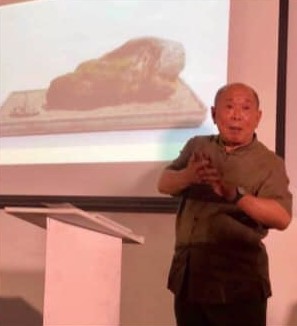
|
||||
| 23 |
1931 -- Legard Duane "Pat" Patterson was born in
Oakland, CA.
[He would go to Oakland Sr. High School,
and then on to UC Berkeley. He would meet
his wife-to-be Thelma at the engineering firm of Bechtel
where they both would work in the offices. They would get married in northern California in the
late 1970s when Thelma's son from an earlier relationship was 19 or 20. (Thelma also would have
a daughter, and Pat would have two daughters from a previous marriage himself.) When Thelma's father fell
ill, Pat and Thelma would then move to Arizona to help out, living in the small town of
Oracle, up the road from Tucson. Pat, who would
have actually been working with bonsai since the 1960s, would take up bonsai again now mainly due to space
limitations at their new house. [Pat would be known to the Internet Bonsai Club's predecessor, rec.arts.bonsai, as dezertrats@aol.com from at least <1999 - 2003. He'd usually prefaced his posts with "G'day all," and end with "Dez of the Arizona High Dezert, at 4550', Oracle, AZ, 2000' above Tucson Sunset Zone 10 USDA Zone 8, aka: Pat and Thelma Patterson... riding off in all directions..." (1999-2001) or "aka: Pat Patterson 'riding off in all directions'." (2001-2006) (His "G'day" greeting would start because one of his older daughters lived in New Zealand for a bit and would later live in Australia.) Pat and Thelma would be with the new club/study group SABE, the Southern Arizona Bonsai Enthusiasts in 2001-2004, for whom in May 2001 he would give a demonstration on "Desert Natives." On the Internet Bonsai Club from May 2009 (the old site would go down because of technical problems in January 2009 and there'd be no archive) until the last of his 277 posts on Aug 18, 2011, Pat's username would be bonsaistud. He would often preface with "G'Day (member's name he'd be responding to)" and close with "Pat...mounted on my trusted steed, riding off wildly in all directions..." [Some notable now archived posts from that period would include: Oct 13, 2009: "G'day Bonsai Friends... My Bonsai Buddy...my wife Thelma... of thirtysomething years, passed away the morning of Friday, September 25, 2009 at 7:03am. Our daughter and granddaughter were with us as she left quietly and peacefully following a restful night... cause of death was, complications due to organs that were damaged by her [third battle with] breast cancer. Since returning home (No. California) two years ago from our 12 year vacation in So. Arizona, my primary 'occupation' was tending to Thelma's needs... coping with breast cancer. About 10 weeks back, she became bed ridden... But she did die in her own home. Thank you for listening... Pat (formerly Dezertrats)" Dec 20, 2009: "...I really miss the infrequent snow we experienced in the Southern Arizona High Desert (Oracle, 4500 feet). We were snowed in for SEVEN days one time...steep, unpaved driveway and no 4-wheel drive. . Maybe the fondest memory of the thirtysomething years with my wife." Dec 25, 2009: "...In the numerous beginners classes that I taught in Southern Arizona, we always provided a "Nana" [Juniper] for each student because, they are easy to work with, they are adaptable to different environments, and they can produce magnificant results as Rob illustrated." Jan 17, 2010: "G'day Boon... My grandaughter's husband (an Antioch homicide detective) took me to the BIB [Bay Island Bonsai] Bonsai Show yesterday, and I saw your [rock planting named] Pandora...stunning...totally outstanding. Much more impressive up close and personal than the photos. And, Boon, what a show! So many bonsai of such great quality. I have never seen so many high quality bonsai in one place and displayed so well... except the National Collection, of course." A Feb 02, 2010 post references Michael Hagedorn: "I have a number of his pots ranging from 1-1/2" X 1-1/2" X 1-1/8" up to a round 14-1/2" X 4" that has a Chihuahua Pine bunjin in it. Most of these pots I got while Mike was packing up stuff for storage... preparing for Japan. We were neighbors... within walking distance... for almost seven years in Oracle, AZ." Apr 04, 2010: "Topic: What is Shohin and what restrictions are there. I'm with you on this one Jim... I have 2 that '...if I can't lift it easily, I don't grow it...' They are 2 of the, now, 6 survivors of The Great Southern Arizona Bonsai Disaster of 2007.. just can't give them up... yet. Anything I acquire now, will be Shohin, or at least Shohin doable." (About two weeks earlier he would mention that the departure of his wife would "get me to open my [eyes] and see what was right there all those years. The fascinating world of SHOHIN. A whole new adventure." He would have already acquired "a wonderful little Picea pungens, Colorado Blue Spruce... it's 21" X 14" [non-shohin-sized], the trunk is 2-1/2" in diameter, at 2-1/2" above the soil. Estimated age is 110 years. It was collected in 2004, and I acquired it last year.") In an Apr 22, 2010 response to RJB about my page Less Usual Plants as Bonsai, Pat wrote: "G'day Robert... How well I remember that Creosote... and helping to unload and reload the many outstanding bonsai from the Phx Bonsai Society for display at ABS'99 in Tucson. I'm the guy who, wearing the cowboy hat, was working the "raffle" tables throughout the Symposium... also drew the honor to give Warren Hill a ride to the airport Saturday night while the auction was in progress... What a shame that the creosote died on Max... that bonsai had such a wonderful history... and that species is known to have lived more than 11,000 years (as in 11K years)... as I'm certain that you know... it is now on the Arizona endangered species list. My wife (my super trouper and bonsai buddy, now deceased) and I met you at the Japanese Friendship Park where I picked up a copy of your book... which you signed for me. We returned home, Northern California, 2-1/2 years back, after a 12 year vacation to Southern Arizona... back to family. ..." [When Thelma's mother would die in 2005 and Thelma would be diagnosed with breast cancer, the couple would move back to California and settle in Antioch. There they would live in an active seniors' home. (A Jun 06, 2010 IBC post would mention "This AncientBonsaiStud rides a three wheeler [a foldable and recumbent Trident Stowaway II] around the ManufacturedHomeSeniorPark, daily.") Pat would have started a Facebook page in June 2009 and his last response -- to birthday wishes -- on that site would be on July 24, 2015. Pat would die in May of 2016 from complications of congestive heart failure, with his stepson and family by his hospital bedside in Livermore, CA.] 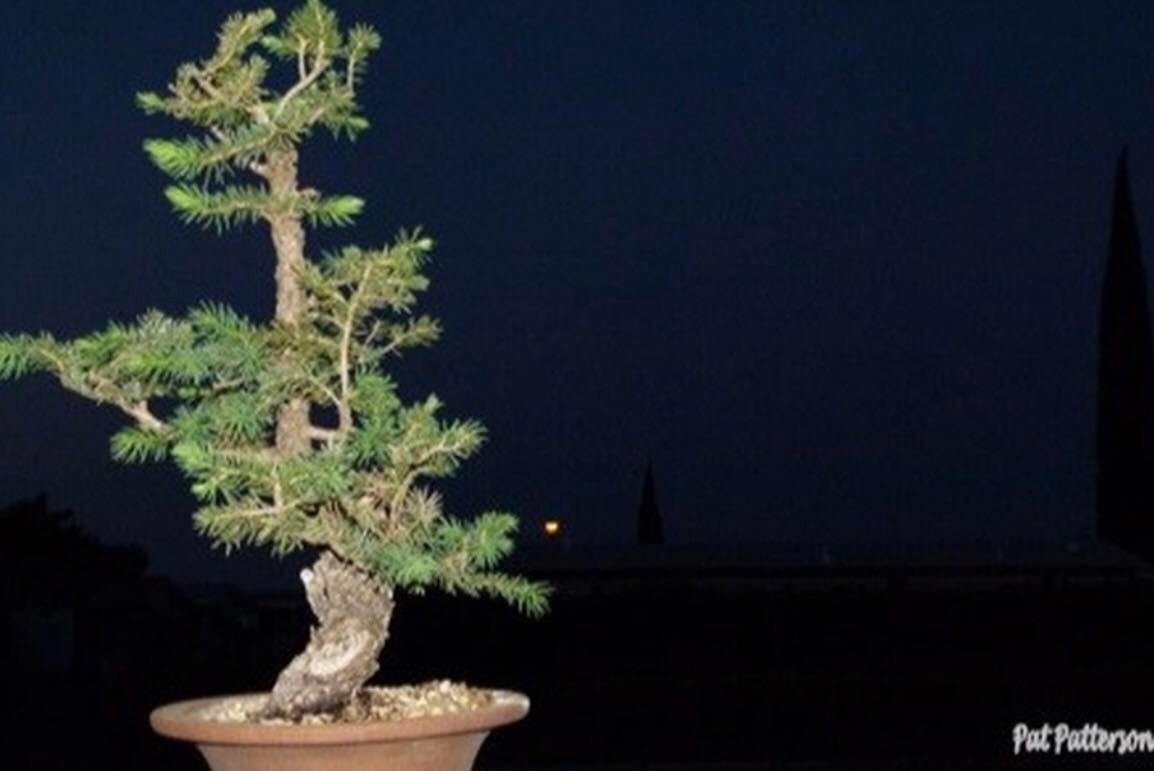
Pat Patterson Pine
Photo courtesy of daughter Nanci Taylor, 09/23/2022
1982 -- The two-day "Art of Bonsai Exhibition" began at the Royal West of England Academy of Art in Bristol. This exhibit was the first to be held in an art gallery in the United Kingdom. The excellent facilities and lighting proved to be the perfect setting for the finest display yet sponsored by the Bristol Bonsai Society. Visitors attended from across the country to view predominantly British trained trees. Sixty percent of the bonsai were British, while forty percent were developed from imported stock. Educational displays, including an audiovisual presentation, were popular with the general public. ("The Art of Bonsai Exhibition," International Bonsai, IBA, 1983/No. 1, pp. 24-25 with 8 b&w photos) SEE ALSO: Jan 4 2015 - Harry Hirao, aka "Mr. California Juniper" and founding president of the Kofu Bonsai Kai, passed away this evening at the age of 98 years. Harry was at home in Huntington Beach with family by his side. He had retired from actively teaching bonsai four years earlier, but still woke up at dawn on most days to putter around and take care of his personal bonsai. See this video about one of the trees he worked on that was then donated to the Pacific Bonsai Museum. (email to Phoenix club president from Manny22816 of Kofu Kai, Jul 24, 2015; McNatt, Cindy, "Bonsai master Harry Hirao," The Orange County Register, Dec. 7, 2013) SEE ALSO: Jan 1, Mar 12, May 9, Nov 3, Nov 6, Dec 28 2018 - Hatsuji Katō, the eldest son of the late grandmaster Saburō Katō, passed away this morning at the age of 76 years. (Valavanis, William "The Passing Of Hatsuji Kato," July 23, 2018, https://valavanisbonsaiblog.com/2018/07/23/the-passing-of-hatsuji-kato/) 2019 - Tarō Kōno, Minister of Foreign Affairs of Japan, awarded French bonsai artist, teacher and carver François Jeker a certificate of honor for his contribution to the dissemination of Japanese culture. [On October 16, Sato Takamasa, Japanese Consul General in Strasbourg, France and Ambassador-Permanent Observer of Japan to the Council of Europe, would officially hand François this certificate in the presence of some fifty guests.] (The French teacher had met John Naka several times -- at least as early as 1991 -- and studied in Japan during at least 3 visits there. His travels have taken him to the U.S., Canada, Germany, and other lands. He designed and built his own Japanese garden. His website, http://www.jeker-bonsai.fr/, dates from 2006. François would have several books published: Esthétique et bonsaï, Vol. 1 (2000, subsequently translated into German, English, and Spanish), Vol. 2 (then translated into German), and Les bois morts de nos bonsaï (2008, translated into English in 2014 as Bonsai Deadwood).) 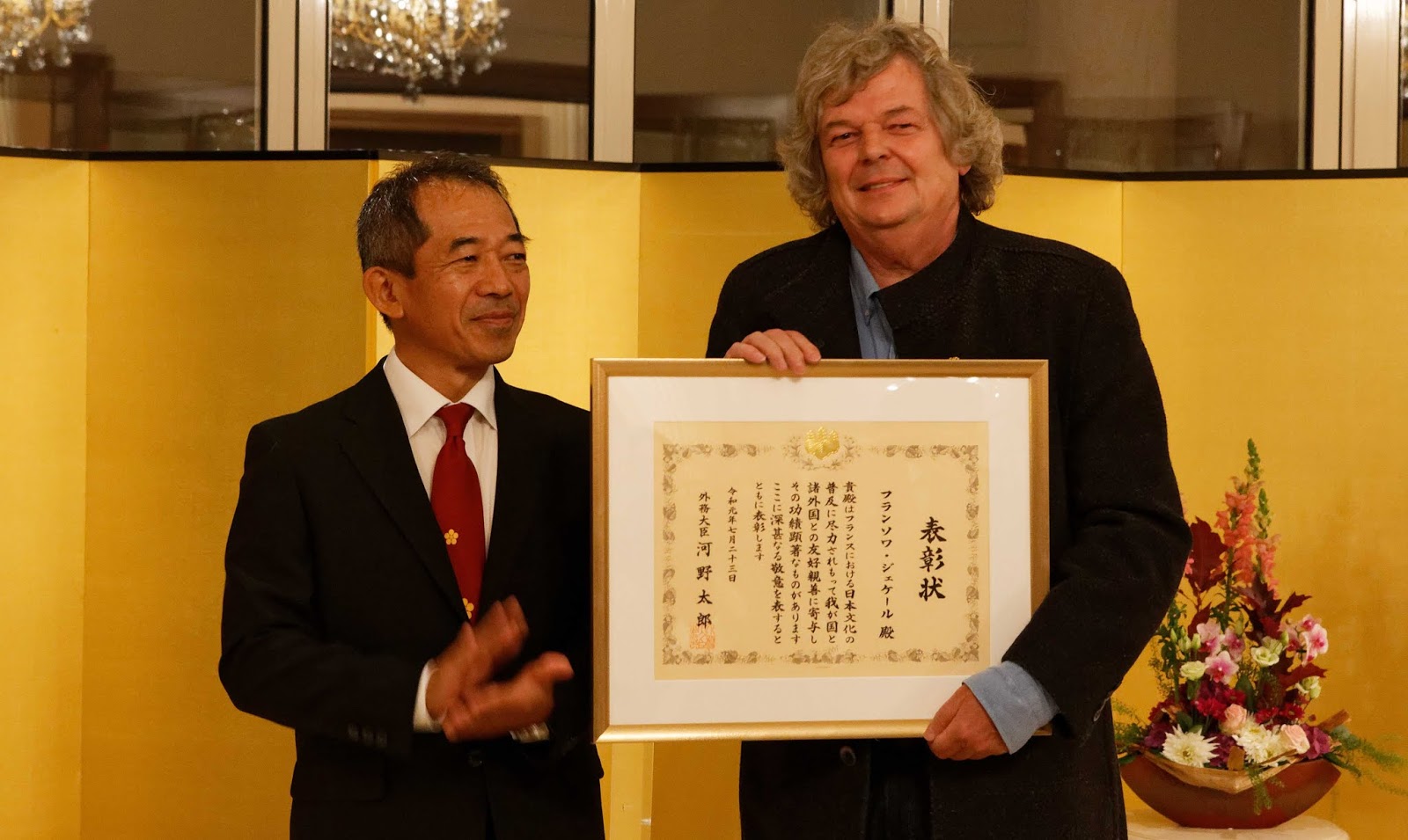
"Sato Takamasa and François Jeker"
("Un certificat d'honneur japonais pour François Jeker / A Japanese certificate of honor for
François Jeker," Esprit Bonsaï, October 30, 2019,
http://blog.esprit-bonsai.com/2019/10/un-certificat-dhonneur-japonais-pour.html
; "Rencontres")
| ||||
| 24 |
|
||||
| 25 |
2010 -- Ruth Stafford-Jones died today at about age 89. Many who knew Ruth
will remember a lady who made a large contribution to the British bonsai scene at a time when few bonsai
societies existed. (She saw her first bonsai in 1959 in a Japanese hotel near Mount Fuji. "They had
them in the garden. I had always known bonsai existed, but when I saw them, I said, 'They're for me'."
There was plenty of time to indulge this new-found interest because, over the next quarter-century, she spent six
weeks of every year in Japan, accompanying her husband, Kenneth, who exported cloth for the fashion
industry. Not long afterwards she made plans to study there. She first studied under Isaburo
Nishiyama in whose nursery all conversation had to be in Japanese. Nishiyama-san was a very gifted careful
and traditional grower. His trees were much sought after by the top nurseries in Omiya to finish off before
selling. Ruth later studied under Susumu Nakamura (b. 1932, Yokohama), she being one of the first westerners to study in Japan under him. At his Shonan School of Bonsai (est. 1976) she obtained a proficiency certificate -- the only non-Japanese to possess one at that time. Apparently when he taught at various organisations Nakamura-san took her along as "a teacher from England," which embarrassed her terribly as she felt she was neither a teacher nor fluent in Japanese. He wanted her to become a teacher so that she could pass on what she had learned. This was something that she was able to do in her own country without embarrassment. During her prolonged periods in Japan she made many bonsai connections and got to know the principal growers in Nagoya and Kyoto, as well as Omiya, and was thus able to bring a number of Japanese bonsai specialists to England where they gave lectures and demonstrations which did much to raise enthusiasm for the art in the UK. During those early years she acquired the bulk of her imported collection of interesting high-quality trees, many of them mature, and they all now bear the imprint of forty years of Ruth's care and devotion. She would buy a few more bonsai in Japan and have them sent back to London. "I would meet the tree at the airport and wait for it to clear quarantine," she said. Later, she started collecting seed in Japan. "If we went to visit a temple, everyone would be looking up, oohing and aahing -- and I would be looking down for seed." She was for many years a member of the Japan Society of London, part of which evolved into Bonsai Kai. In 1964 she joined the Bonsai Kai and was soon a committee member. She became a Royal Horticultural Society judge at the Chelsea Flower Show -- a duty she carried out for 27 years. She ran courses in bonsai at her home and gave talks. She showed her large collection of slides of top Japanese trees to clubs and societies throughout the country for many years. Throughout these years she generously lent trees for Chelsea and other national exhibitions and events. Her special affection for and extensive knowledge of maples was widely known. For a large part of her life, she lived with her husband in Surrey. It became apparent a decade ago that her collection had become so large that it was beginning to be a burden, so she decided she should find it a good home where people could still see it. Her trees were donated to the Kew Gardens in 2001. Her bequeathed collection were the first bonsai Kew had and those 50, some more than 200 years old, reside now with others in the Bonsai House there. Sometime after that she moved down to Cornwall to be close to her family, still caring for some bonsai. Following the establishment of the Association of British Bonsai Artists, Ruth was to become the first ever recipient of that organisation's "Most Prestigious Award," presented to her for her lifetime contribution to bonsai at the 4th ABBA Symposium on Sunday, 16th June, 2002. Those who were privileged to know Ruth will recognise a person very dedicated to bonsai and who engendered motivation and enthusiasm to many, particularly during the 1970's and 1980's when bonsai was emerging as an ever more popular hobby. The UK bonsai scene will be forever in her debt.)
|
||||
| 26 |
2004 -- Jerome "Jerry" Meyer died. (Born on March 20, 1909, he would be a
president of the Bonsai Society of Greater New York before founding the Yama Ki Bonsai Society in 1973. He
authored The Bonsai Book of Practical Facts in 1988.)
("Bonsai News & Notes,"
Bonsai Magazine, BCI, October/November/December 2004, pg. 5) SEE ALSO: Jun 16.
|
||||
| 27 |
2004 -- Three sets (4, 8, and 8 each) of "Bonsai" postage stamps were issued
by the Philippines.
SEE ALSO: Jan 23, Jan 29, Feb 3, Feb 16, Mar 1, Mar 27, Mar 31, Apr 3, Apr 6, Apr 18, May 6, May 29, Jun 16, Jul 20,
Jul 27, Aug 20, Aug 22, Sep 22, Oct 1, Oct 4, Dec 9.
2021 -- "Australia Native Bonsai," a set of three postage stamps, was issued based on specimens at the National Bonsai and Penjing Collection of Australia. SEE ALSO: Jan 23, Jan 29, Feb 3, Feb 16, Mar 1, Mar 27, Mar 31, Apr 3, Apr 6, Apr 18, May 6, May 29, Jun 16, Jul 20, Jul 27, Aug 20, Aug 22, Sep 22, Oct 1, Oct 4, Dec 9. |
||||
| 28 |
1957 -- Sam Adina was born in the Philippines. [He would come to the U.S. in
1982 and eventually be based in Stockton, California.
Sam would began working with bonsai around the year 2000, originally in search of nothing more than a hobby.
He would start that search by raising orchids. "After watering, I saw there's nothing to do," he would
say. Bored, he would get rid of his orchids and try raising koi
but a technical power glitch would cause his koi to die. So a friend would suggest bonsai.] ["I was looking for something to do that is not going out, just staying home," Sam would say. So about the year 2000 he would join the Modesto Club, which would have been formed in 1977. When their sensei George Fujita would retire around 2004, having observed Sam's gift for seeing unique qualities in each tree, he would pass on the "scissors" to Sam as sensei of the Modesto Club. George would recommend that Sam also study under Boon Manakitivipart, an award-winning bonsai master from the Bay Area, and under Johnny Uchida. (George Fujita would pass away at the age of 86 in January 2014.) Sam would also belong to the Yamato Bonsai Kai (of which Johnny Uchida would be the sensei), San Jose Betsuin Bonsai Club, Sacramento Bonsai Club, and the American Bonsai Association of Sacramento, among several other groups. Sam would be highly respected for his remarkable abilities and design talent, and would do demonstrations at many of the area clubs -- and eventually also for the Phoenix, Arizona club. During the 2008 Golden State Federation Convention in Modesto, Sam and three other teachers would help Harry Hirao style a monster California juniper for the entrance of GSBF Collection South. (That tree would unfortunately die during the repotting from grow box to bonsai pot.) In Sacramento at the 2014 GSBF Convention, highly-respected artist Sam would conduct a workshop on his own. He would also win the Best Broad-leaved Evergreen award that year for his impressive olive. Meanwhile, another of his trees would stand in the foyer of the Convention location: a five-foot tall 800 to 900-year-old informal upright Utah juniper that Sam would say he stands on a hydraulic cart to work on. Sam would also do all the bonsai training and design for Blue Oak Nursery in Modesto. As Central and Northern California's largest Bonsai Nursery it would proudly display a collection of over 300 bonsai from world-class artists on the West Coast including Johnny Uchida, Katsumi Kinoshita, Mas Ishii, Boon Manakitivipart, and Roy Nagatoshi, to name just a few.] (email to RJB from Carol Roberts, Phoenix Bonsai Society; "March Meeting Tuesday, March 27th at 7pm," The Bent Twig, March 2012, pg. 1, http://www.abasbonsai.org/newsletters/mar2012.pdf; "Trees of the 2014 GSBF Convention," California Bonsai Art, https://bonsaial.wordpress.com/tag/sam-adina/; "Bonsai, art of the tree world, on display this weekend at Modesto show," The Modesto Bee, April 25, 2014, http://www.modbee.com/living/article3163844.html; "Showtime!," Valley Bonsai Society, Newsletter, Vol. 3 March 1, 2009, pg. 1, http://www.valleybonsaisociety.com/NewsLetters/Newsletter%20Vol%203%20-%20March%201%202009.pdf; "Harry Hirao, aka, The Goat, Mr California Juniper," California Bonsai Art, http://fastproxynetwork.appspot.com/bonsaial.wordpress.com/2015/07/24/r-i-p-harry-hirao/; "Does anyone have photos of the winning trees from the 2014 GSBF Convention?," Ask Bonsai Tonight, Nov. 10, 2014, http://ask.bonsaitonight.com/t/does-anyone-have-photos-of-the-winning-trees-from-the-2014-gsbf-convention/30; http://blueoaknursery.com/) SEE ALSO: Feb 19, Mar 12, 2019 -- Iris G. Cohen, the "little old Jewish grandmother of bonsai," passed away at the Jewish Home of Central New York at age 89. (She had been an early member of the Internet newsgroup rec.arts.bonsai, which would later be renamed as the Internet Bonsai Club.) ("Iris Cohen," syracuse.com) SEE ALSO: Aug 24 2021 -- In the early hours of the day, Mary Madison died at age 91. (She had been born in Florida in 1929. During the Great Depression, her father took the "little brat" (3rd or 4th grades) on rides with him down to the natural beauty displayed in the Florida Keys, unaware that each trip solidified her love of the natural environment and sparked her passion for horticulture. She grew plants as a small child since the family had no nearby neighbors to keep her company in Homestead (near Miami). A born naturalist, Mary would spend the rest of life sharing her love of all living things with strangers and friends alike. In the 3rd grade on a field trip she saw artifacts brought back from a stay in Japan. She held a little jade bowl and just fell in love with it. Her first taste of bonsai later came in the form of photos from her boyfriend who served in Japan with the first Occupational Forces after World War II. The boyfriend was originally scheduled to be part of the U.S invasion force to Japan, but the dropping of the atomic bombs ended that mission and he ended up guarding prisoners in Japan after the war. He sent Mary presents and pictures of bonsai. These bonsai images spurred her to try tree-training herself, putting her long-time interests in Asia and plants together. "It's been a love affair ever since." (She later saw a little ad in a newspaper about bonsai lessons at Ponce de Leon High School in Miami. She went to the class and was hooked ever since. Her husband TJ, who had originally met Mary at a party while her first beau was still in Japan in the Army, gave her a buttonwood tree (Conocarpus erectus) he had collected around 1960. She practiced bonsai on her own for over a decade. After the war she had helped prospective home-buying veterans fill out FHA and VA applications for a short time. TJ then went into business for himself with a mirror and glass cutting business at which Mary briefly worked. She joined the club in Miami in 1972 (eight years after it was formed). The next year Mary participated in the founding of the Bonsai Societies of Florida (BSF), typing the initial by-laws and putting out the newsletter. In 1974 she went with a friend out to California to get ideas for the first Florida convention scheduled for the following year. At this joint American Bonsai Societies/Bonsai Clubs International (ABS/BCI) Pasadena event in July, attended by more than 500 enthusiasts from the U.S., Japan, Australia, and Canada, she met Ben Oki and John Naka. She saw that their trees -- including John's forest Goshin -- "were just out of this world. I thought if only I could do that..." Mary ended up studying under these two world-renowned bonsai masters until their deaths. She became known as "The Bonsai Buttonwood Queen," a title given to her by Ben Oki (per 11:17 mark in Bonsai Supply video) but later widely attributed to John Naka. One of the early times John came out to Florida for what were becoming annual workshops, Mary educated him on the beauty of buttonwood as a bonsai species. She would continue to annually visit California shows for the next 30 years. She met Florida tropical bonsai artist Joe Samuels at that first convention where they became friends back home and later tree-digging companions. Her husband TJ would also join them for digging labor in the Everglades. (A grandson would eventually take his place helping Mary collect trees along with Mary's daughter, who was his mother, and with his father.) Mary also favored [bald] cypress (Taxodium distichum) and Bucida spinosa for bonsai in addition to keeping several other species, of course. (A buttonwood in training since 1975 was gifted by Mary to the National Bonsai & Penjing Museum in 1990. Another tree, that she had collected in 1989, would eventually join the Museum in 2019 after a curious curving path. A video tour of her home and garden in Lake Placid, Florida was published in April 2018. (A few years earlier it had been estimated that probably 80% of all the buttonwoods that have been displayed in high profile shows were among the thousands orginally collected in the wild by Mary somewhere "south of Miami." She specialized in rescuing the trees before the bulldozer rips them out of the ground to make way for another retirement condo or timeshare highrise, sometimes post-hurricane. She was still living in Homestead (near Miami) in 1992 when Hurricane Andrew hit and she rode it out with her favorite trees. She used mostly organics in her soil for buttonwood because "they love to be wet" (unlike most other species used for bonsai). In 1986 she gave a lecture and workshop on buttonwoods at the joint ABS/BCI convention in Washington, DC. The Miami (with BSF) in 1993 and St. Louis, MO in 2004 were two other joint conventions she demonstrated at. She similarly participated in BCI conventions in Orlando, FL in 1983, Memphis, TN in 1992, Orlando in 1993 (aka the 2nd World Bonsai Friendship Federation convention), and Miami, FL to the Bahamas on Royal Caribbean's Majesty of the Seas cruise ship in 2001. Other Bonsai Societies of Florida conventions were St. Petersburg in 1986, Ft. Lauderdale in 1996, Fort Myers in 2003, and Orlando in 2009. She demonstrated at the Brussel's Bonsai Rendezvous in Olive Branch, MS in 1998, and at the 5th World Bonsai Convention in Washington, DC in 2005. She was interviewed by deadwood artist David Cutchin in a detailed one-and-a-half hour-long podcast for Bonsai Mirai's Asymmetry which was published on 21 Feb, 2021. (Mirai's founder Ryan Neil collected with Mary in Florida and Cutchin was also a student of Mirai.) The following May, the Bonsai Societies of Florida named their annual native species award the "Mary Madison Award" to pay homage to her immense contributions to the art of bonsai. (Mary exemplified what it is to be a good person. She treated everyone with kindness and humility, her resolve was to do what's right and forgive regardless of the situation. A ittle wise crack from Mary and she'd have you laying down your guard eating out of the palm of her hand. She intuitively knew that your happiness meant her happiness. She was a catalyst of human decency, hard work, and love to anyone she befriended. A seemingly romantic gesture to her late husband TJ, who had died in 2004, she parted earth like the lyrics from their favorite song by The Platters. "Heavenly shades of night are falling, it's twilight time. Out of the mist your voice is calling, tis twilight time... I count the moments darling til you're here with me. Together at last, at twilight time...") 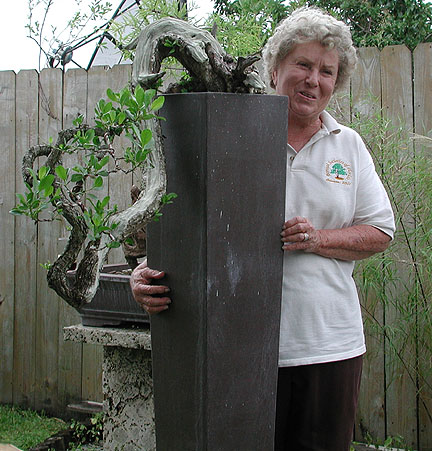
Mary Madison & a kengai buttonwood, 10/13/01.
(Memorial by David Cutchin, as posted on FB by Bonsai Societies of Florida, 07/28/21, reproduced
by Knowlton, Michael, "Florida makes an impression at the 7th U.S. National Bonsai Exhibition in Rochester,"
The Florida
Bonsai Magazine, Summer 2021; "Museum
Donor and Buttonwood Queen Dies at 91," NBF Blog, August 3, 2021;
Mary Madison, podcast for Bonsai
Mirai's Asymmetry, 21 Feb, 2021 (referenced by meushi on Bonsai Nut,
Aug 12, 2021);
"Bonsai Garden Tour with Mary Madison - The Bonsai Supply,"
25 Apr 2018; adamaskwhy,
"A lazy
Sunday with Mary Madison, bonsai Buttonwood Queen," August 17, 2015;
"Interview with Mary Madison, the Bonsai Buttonwood
Queen video by Adam Lavigne, 1 Nov 2016) SEE ALSO: Jan 26, Apr 26,
Nov 9, Nov 21.
(Photo courtesy of Alan Walker, 05/11/07) |
||||
| 29 | 1933 -- Bernard Coetzee was born. [He would become one of South Africa's pioneering and leading bonsai artists and a mentor to generations of bonsai growers there.] (Dedication in Acknowledgements of "Bonsai in South Africa: Your Collection" by Carl Morrow, Veld & Flora, September 2001, pg. 133) SEE ALSO: Jan 16, Jan 25, Apr 8, Aug 25 | ||||
| 30 |
1992 -- Bunjae Artpia, the Spirited Garden, the world's largest
bonsai park was opened after three years of construction work about 40 km northwest of Jeju (Cheju) City on Jeju Island,
southwest of the Korean peninsula. Some 2,000 potted trees of about 100 species are displayed outdoors and indoors
on a 33,000 sq.m. site on the island with strong sunshine and northwesterly seasonal winds. The pathways consist of
five courses. The 53-year-old Mr. Bum Young Sung dedicated 30 years to the planning and construction of this private
park which is opened to tourists. He is assisted by a staff, and his wife, son, and daughter. (Born in Yongin-gun in Gyeonggi province, South Korea in 1939, and educated in Seoul in the heart of that province (where he first saw bonsai at a flower garden), Sung spent three years in the army. After that in 1963, he first visited the financially-poor but agriculturally-rich island of Jeju, where an army buddy was from. The friend later offered Sung the opportunity to buy some tangerine fields on Jeju, which was accepted. He opened a dress shirt store in 1967 in Seoul, changing locations there until he found an advantageous site. He made custom shirts, kept meticulous records of his clients' needs, and had many foreigners become his customers. He prospered and bought more stores there. He bought more land on Jeju, swapped some land for new pieces, and eventually started to reclaim the land, build stone fences, and plant trees on land the locals claimed would "never be developed even in a hundred years." During the times he spent on Jeju, his wife ran the plant and store in Seoul. Sung moved his residence to the island in 1974. He started to raise pigs and cows for a while, the proceeds from livestock sales going to bonsai materials and bonsai growing in the field. He cut down his tangerine trees (ahead of what turned out to be a correct belief in an eventual oversupply of tangerines in the area) and was totally committed to growing trees. In early 1987, the sub-county chief of the area had, in fact, visited Sung and suggested that he develop his large landscape-tree-planted farm into a tourist attraction. After much doubt and consideration, Sung decided to build a uniquely Korean style presentation making use of Jeju's orum or volcanic hump. Numerous imported trees including many palms were brought in over the next year, and a license was obtained in April 1990. A pond and waterfall was constructed, restaurant and ticket booth set up, and hills were built out of more than 6,000 truckloads of earth and stones.) [Only about one quarter of the construction was completed by opening day. The Garden would be repaired and expanded every year, with work on the high stone walls ("fence") which offered some protection from the local winds and six stone gates conducted almost every year. A Bonsai Exhibition Center would be added. The large potted trees remain outside most of the year, being moved into the greenhouse only if recently transplanted, extremely sensitive to winter cold, or ahead of approaching typhoons (in August to as late as October). Daily lunch-time guests would average 400 to 500, with busy days of 800 to 1,200 persons. Initially, the attitude of Korean tourists would be deplorable, many behaving boorishly, touching trees and picking their fruits, complaining that bonsai is of Japanese background or that the trees were tortured by binding them with wire or taken recklessly from mountains, not reading the explanation boards throughout the park or listening to the guides. After the financial crisis of 1997, the people would have become quieter, appreciating the trees in silence, and paying more attention to the information boards. A nine-page article in International Bonsai Magazine about the garden following William N. Valavanis' visit in 1996 and a subsequent follow-up visit and workshop with 30 Western enthusiasts would increase appreciation of Korean bonsai in the world. Numerous dignitaries, tourists and enthusiasts from all over the world would visit, including many from North Korea and China. On occasion Sung would continue to go to Japan to attend the Kokufu-Ten (being especially proud of the many native Korean trees in that prestigious competition) and visit the Omiya nurseries. The Asian financial crisis would actually result in two attempted auctions of the property to satisfy bank debts. National press stories about the desperate situation would result in some support and donations from the public and corporations, which ultimately would aid Sung in saving the Garden. Throughout this time and afterwards, Sung would be invited to China to speak on his spirit of pioneering, how a farmer would create a world-class art piece with no support from the government. He would be recommended as a model for the movement to create parks and plant trees for social reform in China, being the subject of numerous interviews and articles. Sung would be invited to go to China at least 26 times, visiting several of the botanical gardens to have a look at the current status of bonsai there. He would sign a mutual partnership agreement in July 2000 with the Hong Yuan Penjingyuan (bonsai park) and become an honorary director of that municipal park in Yangzhou. [Sung's book about the Garden would be published in 2005 with editions in Korean, Chinese and English.] The website http://www.spiritedgarden.com/ tells the story.] (http://www.icpop-korea.org/second/chejutour.html; Bum-young Sung The Spirited Garden (Kyung-Gi-do, South Korea: Gimm-young books; 2005), pp. 9-10, 65, 102-103, 109, 113-114, 127-129, 144-145, 149, 155-157, 171, 204-214, 222-223, 227-230, 236-240, 249-250, 253, 261-262) |
||||
| 31 |
|
